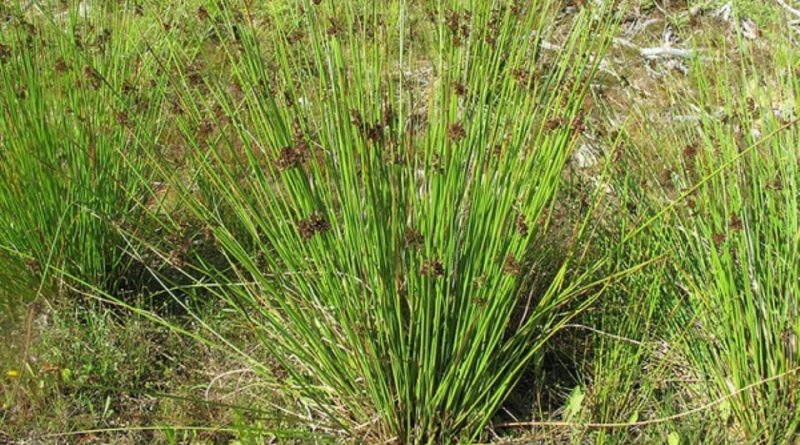Juncus effusus
Juncus effusus
The common rush (Juncus effusus L.) is a herbaceous species belonging to the Juncaceae family.
Systematics –
From a systematic point of view it belongs to the Eukaryota Domain, the Plantae Kingdom, the Magnoliophyta Division, the Liliopsida Class, the Poales Order, the Juncaceae Family and therefore to the Genus Juncus and to the Species J. Effesus.
The terms are synonymous:
– Juncus effusus subsp. fistulosus (Guss.) Cif. & Giacom .;
– Juncus fistulosus Guss ..
Etymology –
The term Juncus comes from the Latin name of the rush, from iúngo to join: for the use made of it to make ties.
The specific epithet effusus comes from effundo effusione, spread: scattered around, diffused.
Geographical Distribution and Habitat –
Juncus effusus is a sheared bushy marsh plant, particularly widespread in the maritime areas of all continents, suitable for swampy areas with a few cm of water, or for moist soil.
Its habitat is represented by marshy areas but with clear water and is widespread above all in areas with a humid climate, in marshy and maritime ones, but also in shady woods.
Description –
The common rush is a perennial plant that can reach a height of up to one hundred and twenty centimeters.
It has creeping rhizomes, green, cylindrical and erect stems. The leaves can be linear or cylindrical, they are placed at the base of the stem.
In summer, on the tops of the stems it produces bronze-brown inflorescences with a rounded shape.
The brown fruits, decorative throughout the summer, appear at the ends of the stems. These are 1,5-2,3 mm capsules, often shorter than the tepals, obovoid or ellipsoid, trigone, obtuse, truncated or slightly retuse, with transversely wrinkled valves, yellowish or brownish, bright, without beak.
The seeds are 0.4-0.5 mm, ovoid, reticulated, yellowish or rust colored.
Cultivation –
Common rush is an aquatic and perennial bushy plant. It prefers acidic and wet soils, in fact the typical environment are lakes, rivers, swamps, etc. This plant likes to be exposed in areas full of sun and also needs a few hours of direct sun. It resists very well even in cold temperatures so it can be grown outdoors all year round.
The planting is carried out in good-sized boxes with soil mixed with peat and sand and introduced underwater or at the edges of a pond or other body of water.
The rush needs a constantly humid soil, for this reason it is necessary to supply water regularly every fifteen days. Generally the rush is placed at the bottom or on the banks of reservoirs but, if grown in a container, the water will be changed every twenty days.
As with other aquatic plants, fertilizer will also be added to the rush by dissolving it in water, there are specific ones on the market for this type of plants. The best time to fertilize the rush is spring.
The multiplication of the rush occurs by division of the rhizomes. During the autumn season, this division must be carried out and, subsequently, the rhizomes should be planted in a soil, peat and sand compound and introduced into the water.
The common rush is very resistant and therefore is hardly attacked by parasites but despite this it can sometimes present floury cochineal and black aphids.
Customs and Traditions –
Juncus effusus is a plant used not only for ornamental areas of marshy areas or ponds and waterways but also for phytoremediation.
The stems and cylindrical and semi-persistent leaves, light green, are used in the basket. Once, in fact, it was often used to create baskets, coatings, candle wicks, etc.
Rush seeds coming into contact with water take on a sticky consistency and, by attaching themselves to the legs of birds, cause them to spread them.
Preparation Method –
The common rush has no particular interest either from a food or pharmaceutical point of view. Its use as a plant for phytodepuration plants is interesting.
Guido Bissanti
Sources
– Acta Plantarum – Flora of the Italian Regions.
– Wikipedia, the free encyclopedia.
– Treben M., 2000. Health from the Lord’s Pharmacy, Advice and experiences with medicinal herbs, Ennsthaler Editore
– Pignatti S., 1982. Flora of Italy, Edagricole, Bologna.
– Conti F., Abbate G., Alessandrini A., Blasi C. (edited by), 2005. An annotated checklist of the Italian vascular flora, Palombi Editore.
Warning: Pharmaceutical applications and alimurgical uses are indicated for informational purposes only, they do not represent in any way a medical prescription; therefore, no responsibility is accepted for their use for healing, aesthetic or food purposes.


